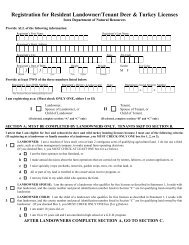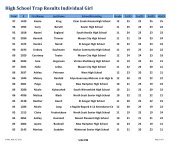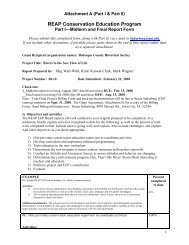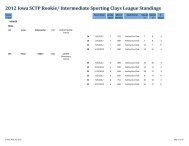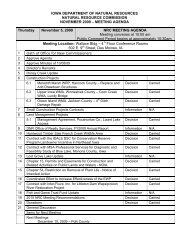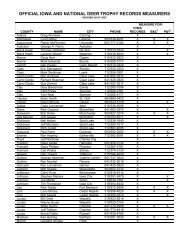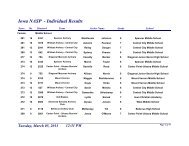iowa department of natural resources npdes permit application
iowa department of natural resources npdes permit application
iowa department of natural resources npdes permit application
You also want an ePaper? Increase the reach of your titles
YUMPU automatically turns print PDFs into web optimized ePapers that Google loves.
FORM 2F INSTRUCTIONS DO NOT SUBMIT THESE PAGES – FOR APPLICANT USE ONLY<br />
Part VII-B - List all pollutants that are limited in an effluent guideline which the facility is subject to (see 40 CFR<br />
Subchapter N to determine which pollutants are limited in effluent guidelines) or any pollutant listed in the facility's<br />
NPDES <strong>permit</strong> for its process wastewater (if the facility is operating under an existing NPDES <strong>permit</strong>). Complete one<br />
table for each outfall. The “Average Values” column is not compulsory; but should be filled out if data are available.<br />
Analyze a grab sample collected during the first thirty minutes <strong>of</strong> the discharge and flow-weighted composite samples<br />
for all pollutants in this Part, and report the results, except as provided in the General Instructions.<br />
Part VII-C - Part VII-C must be completed by all applicants for all outfalls which discharge storm water associated with<br />
industrial activity, or that the State <strong>of</strong> Iowa is evaluating for designation as a significant contributor <strong>of</strong> pollutants to<br />
waters <strong>of</strong> the state, or as contributing to a violation <strong>of</strong> a water quality standard. Use both a grab sample and a<br />
composite sample for all pollutants you analyze for in this part except use grab samples for residual chlorine and<br />
Escherichia coli (E. coli). The “Average Values” column is not compulsory but should be filled out if data are available.<br />
Part C requires you to address the pollutants in Table 2F-2, 2F-3, and 2F-4 for each outfall. Pollutants in each <strong>of</strong> these<br />
Tables are addressed differently.<br />
Table 2F-2: For each outfall, list all pollutants in Table 2F-2 that you know or have reason to believe are discharged<br />
(except pollutants previously listed in Part Vll-B). If a pollutant is limited in an effluent guideline limitation to which the<br />
facility is subject (e.g., use <strong>of</strong> TSS as an indicator to control the discharge <strong>of</strong> iron and aluminum), the pollutant should be<br />
listed in Part Vll-B. If a pollutant in table 2F-2 is indirectly limited by an effluent guideline limitation through an<br />
indicator, you must analyze for it and report data in Part Vll-C. For other pollutants listed in Table 2F-2 (those not<br />
limited directly or indirectly by an effluent limitation guideline), that you know or have reason to believe are discharge,<br />
you must either report quantitative data or briefly describe the reason the pollutant is expected to be discharged.<br />
Table 2F-3: For each outfall, list all pollutants in Table 2F-3 that you know or have reason to believe are discharged. For<br />
every pollutant in Table 2F-3 expected to be discharged in concentrations <strong>of</strong> 10 ppb or greater, you must submit<br />
quantitative data. For acrolein, acrylonitrile, 2, 4 dinitrophenol, and 2-methyl-4, 6 dinitrophenol, you must submit<br />
quantitative data if any <strong>of</strong> these four pollutants is expected to be discharged in concentrations <strong>of</strong> 100 ppb or greater.<br />
For every pollutant expected to be discharged in concentrations less than 10 ppb (or 100 ppb for the four pollutants<br />
listed above), then you must either submit quantitative data or briefly describe the reason the pollutant is expected to<br />
be discharged.<br />
Small Business Exemption - If you are a “small business,” you are exempt from the reporting requirements for the<br />
organic toxic pollutants listed in Table 2F-3. There are two ways in which you can qualify as a “small business”.<br />
i. If your facility is a coal mine, and if your probable total annual production is less than 100,000 tons per year, you<br />
may submit past production data or estimated future production (such as a schedule <strong>of</strong> estimated total<br />
production under 30 CFR 795.14(c)) instead <strong>of</strong> conducting analyses for the organic toxic pollutants.<br />
ii. If your facility is not a coal mine, and if your gross total annual sales for the most recent three years average less<br />
than $100,000 per year (in second quarter 1980 dollars), you may submit sales data for those years instead <strong>of</strong><br />
conducting analyses for the organic toxic pollutants. The production or sales data must be for the facility which is<br />
the source <strong>of</strong> the discharge.<br />
The production or sales data must be for the facility which is the source <strong>of</strong> the discharge. The data should not be limited<br />
to production or sales for the process or processes which contribute to the discharge, unless those are the only<br />
processes at your facility. For sales data, in situations involving intracorporate transfer <strong>of</strong> goods and services, the<br />
transfer price per unit should approximate market prices for those goods and services as closely as possible. Sales<br />
figures for years after 1980 should be indexed to the second quarter <strong>of</strong> 1980 by using the gross national product price<br />
deflator (second quarter <strong>of</strong> 1980= 100). This index is available in National Income and Product Accounts <strong>of</strong> the United<br />
States (Department <strong>of</strong> Commerce, Bureau <strong>of</strong> Economic Analysis).<br />
Form 2F – Page 9<br />
4/18/11 ccsw DNR Form 542-1380



